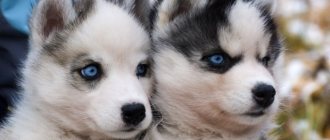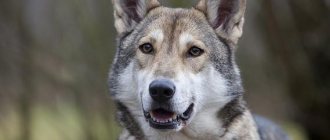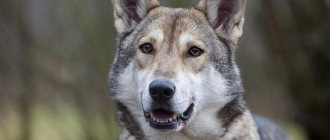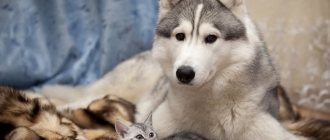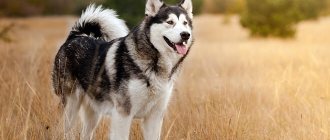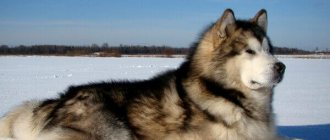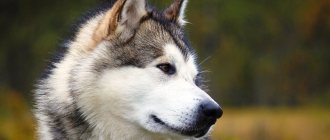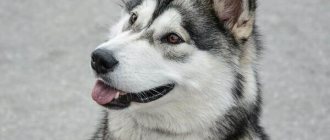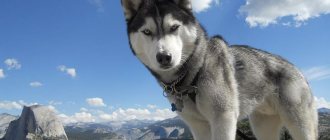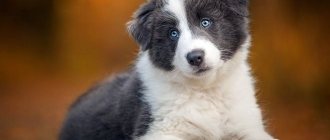Malamutes are distinguished by their incredibly beautiful appearance and wonderful character; they are devoted to their owners and do not show aggression towards strangers.
However, along with this, they have one significant drawback - their specialization is too narrow, making it impossible to use them, for example, as guards or hunters.
It was in order to make Malamutes a more universal breed that serious selection work was carried out, as a result of which many mestizos were born.
Most of them, in addition to large stature, strong physique, strength and endurance, have also inherited the most characteristic features of the Malamute exterior, such as thick hair, erect triangular ears and a characteristic friendly and phlegmatic expression of the muzzle.
Story
The Malamute dog breed got its name in honor of the Malamute tribe, which lived on the shores of Alaska. They were a hardworking and peaceful people. The ancestors of the Alaskan Malamute were powerful animals with thick fur. They served faithfully - they ran in sleds and transported heavy boats.
At the beginning of the 20th century, Alaska was gripped by a gold rush. At this time, the Malamute dog breed received an additional impetus for development. The demand for these hardy animals increased. Gold miners tried to get to Alaska, but many did not succeed, and they died on the road. Only those who used a team with malamutes got there.
Despite the increase in the number of dogs, such interest in them also had negative consequences. Gold miners crossed the Malamute with other breeds of dogs, trying to produce an animal with maximum speed and endurance. These “experiments” led to the fact that only a few litters of purebred Malamutes remained.
Crossbreed with a wolf
Many people confuse these mestizos with wolf-dogs, considering them to be the same breed. But, in fact, wolfmutes - and this is what such a crossbreed is called - have nothing in common with wolfdogs.
Outwardly, they are more similar to Malamutes - they have the same thick and dense, slightly elongated hair, forming a characteristic small collar on the neck, as well as feathering on the hind legs and tail.
In size, such dogs are somewhat larger than Malamutes - their height is, on average, from 65 to 75 cm, but depending on how the genes are distributed, a mixed-breed puppy can grow up to be slightly larger or smaller than the average height. But Volkomuts have a lighter frame and are more mobile than the phlegmatic Malamutes.
IMPORTANT!
By nature, volkomuts are not very aggressive towards outsiders, but they have a strong distrust of them.
Considering their more “wolfish” appearance than that of a purebred Malamute, as well as some irritability and unpredictability of behavior inherited from a wild predator, this can lead to certain problems when raising these dogs, as well as to conflict situations.
You also need to take into account the fact that such mestizos are characterized by increased aggression towards other dogs and the instinct to pursue prey. Therefore, wolfmutes need timely and very early socialization, proper education and professional training.
External features
The Malamute dog has quite impressive dimensions: the height at the withers of a male is 63 cm, that of a female is about 59 cm. The average weight is 35-38 kg, but there are also more massive individuals.
The dog's head is large, regularly rounded. The muzzle is voluminous, but not elongated. The ears are erect and quite elegant, triangular in shape. They are set wide apart, slightly rounded at the tips.
The jaws are well developed and powerful. The teeth are large and sharp. The eyes are almond-shaped, small, brown. Blue color is a serious fault.
The nose is almost always black. The only exceptions are red malamutes. Their lobes may be brown.
The neck is powerful and strong, somewhat curved. This gives the dog extra grace. The chest is wide. The back is straight, with a strong and muscular lower back. The Malamute dog has a provocatively curling fluffy tail.
The limbs are straight, set parallel to each other. Powerful paws resemble those of a bear. They have strong bones and developed muscles.
Character
It is impossible to describe a Malamute without mentioning its character. This is a friendly and benevolent animal. He needs to always be the center of attention. Therefore, he is an excellent pet for large families with children. Despite its impressive size, the dog can become a gentle and caring nanny for babies.
The Malamute dog loves its owners immensely and becomes attached to them with all its soul. True, it always requires reciprocity from a person. This is a pack dog - it is vital for her to be in a family. And it is not so important whether the members of this family are his brothers or people.
Malamutes should not be kept in a closed enclosure. He cannot stand loneliness at all - the dog may lose trust in the owner, love, respect for him.
It is worth remembering that once you undermine trust by offending your Malamute, you will lose his respect forever. It is impossible to return it. He will switch all his love to another family member. This cannot be called betrayal on his part. Since dogs of this breed are very smart, and also stubborn, they quickly get bored with repetitive and monotonous actions. In other words, if you force your pet to fetch a newspaper or slippers every day, he may perceive it as disrespect and will remember it for a long time.
In this regard, experienced dog handlers do not recommend that beginners in dog breeding purchase such dogs. Without knowing how Malamute puppies are raised, a beginner can make irreparable mistakes.
As already mentioned, these dogs are very stubborn. This often interferes with their learning. But they are so inquisitive and endowed with such powerful intelligence that they are able to remember even complex commands the first time. They will fulfill your orders and requests, but no more than 1-2 times. They will then get bored and lose interest in learning.
If, flattered by the size of this animal, you decided to purchase it as a guard, then we hasten to disappoint you. The Alaskan Malamute will not use this “arsenal” under any circumstances. He is completely devoid of aggression towards humans. This can be explained by his natural kindness and friendliness. The Malamute will not rush at a stranger unless he poses a real threat to the dog or its owner. He will treat family friends warmly and kindly.
Husky mix
Hybrids of Malamutes and Laikas, bred to improve the running speed of dogs, are distinguished by lighter bones and a friendly, calm disposition. Interbreeding with huskies was also carried out so that the hybrids, distinguished by their robust build and endurance, could become reliable hunting assistants.
Outwardly, they look somewhat larger and more massive than huskies, in addition, their fur is usually medium in length. Their facial expression is not so phlegmatic and good-natured: the look of the Malamute-Laika mix expresses attentiveness and interest, while that of the Malamute is calm and at the same time friendly.
NOTE!
The coat color of a mestizo can be any color, including those that are unacceptable for a standard purebred Malamute, for example, piebald.
By nature, mixed breeds with huskies are usually quite friendly towards people, and they have a well- developed hunting instinct , thanks to which their dogs can also be used for hunting.
Maintenance and care
This noble and beautiful dog needs careful care.
The Malamute is a big fan of water treatments. The dog simply cannot be pulled out of the water. With such a luxurious fur coat in the summer heat, bathing is vital for him.
The most important thing is to thoroughly rinse the hair to remove any remaining shampoo. After bathing, the Malamute must be dried. Otherwise the wool will roll off.
The dog will need help from its owner during shedding. It happens twice a year - in spring and autumn. At this time, you need to carefully comb the fur. Otherwise, your pet will be covered in tangles, and dog fluff will fly around the house.
The Malamute has sharp and long claws that need to be ground or trimmed periodically. Wipe your eyes once a week, clean your ears once a day.
Laika Malamute
This breed name is incorrect. These dogs (Laika and Malamute) are often confused. We will try to talk about the differences between these animals. We would like to note right away that huskies and malamutes are not huskies. Let's say more: huskies are significantly inferior to them in the harness, but they are in the lead in the hunt. Therefore, the “Malamute husky” does not exist in nature. There are malamutes and huskies - sled dogs, and there is a husky - a hunting dog. These breeds are long-time friends and helpers of humans.
German Shepherd mix
A cross between a Malamute and a German Shepherd received a beautiful and unusual name - utonagan , which translated from one of the Indian dialects means “spirit of the wolf”.
And, indeed, outwardly, Utonagans are very similar to wild gray predators, although they are somewhat smaller and longer-haired. The size of the utonagan can range from 55 to 65 cm, which is quite commensurate with the growth of both malamutes and shepherd dogs. The physique of these dogs is strong, but without signs of excessive massiveness or stockiness.
Having inherited a benevolent disposition from the Malamute, and impeccable obedience, distrust of strangers and innate hunting instincts from the Shepherd, this mixed breed is a universal breed, ideal for the role of a companion. He has a beautiful and extraordinary appearance, is strong, resilient and friendly towards his owners.
The service qualities and obedience inherited from the shepherd significantly facilitate the process of training a Utonagan and make it possible to use these dogs to guard a house or apartment.
Utonagan is ideal for the role of a family dog - he is good-natured, calm and very good with children.
Husky. Malamute. Differences
These animals are confused even more often. Probably because they are very similar in appearance. But that's where their similarities end.
Malamute, unlike huskies, is very stubborn and incredibly resilient. The Siberian Husky can be harnessed to a sled. He may even win the race, but he will not be able to carry an impressive load over a long distance for a long time. In addition, huskies are faster and smaller in size.
The Malamute is capable of performing any, even the most difficult, work. These are the largest and strongest among all sledding breeds.
Visual differences between dogs
Look at these photos, we are sure that after this there will be no questions left about how the Alaskan Malamute differs from the Siberian Husky:
Husky
Malamute
Husky
Malamute
And these are the puppies:
Choosing a puppy
It’s probably not worth saying that such a dog cannot be purchased at the poultry market. As a result of such a purchase, you can get a very cute puppy... mongrel. Of course, he can also become a faithful friend, but we need a dog of a specific breed, don’t we? We are interested in the Malamute. The price for these dogs is quite high (we’ll talk about this later), so if you are offered an excellent puppy for a couple of thousand rubles, feel free to pass by.
Having decided on a nursery, you need to start getting acquainted with your future pet. Look at the room in which adult dogs and puppies are kept. The Alaskan Malamute should be kept with its mother and its brothers in a dry, well-ventilated (but without drafts) room.
Pay attention to the baby's behavior - he should be mobile, active, and have a good appetite. Healthy Malamute puppies have thick, shiny fur and clear eyes and ears. Find out about all the vaccinations your baby has received and check out the schedule for further vaccinations. Find out from the breeder how the baby’s stomach works, because quite often the main health problem in Malamutes is related to the gastrointestinal tract. Check the availability of certificates for the removal of parasites.
See how puppies behave in their family. The Alaskan Malamute should play with its brothers at an early age.
If possible, get to know the baby's parents. Look at their awards, study their pedigree. Watch how they behave. Often the baby is a reflection of its parents. Do not take the first Malamute offered to you. Watch the puppies for at least an hour. Pay attention to the manifestation of overt or hidden aggression. Under no circumstances should you purchase such a puppy.
It is important that a spark of love and mutual understanding runs between you and your future pet. Only in this case will you find a faithful and devoted friend, a sensitive companion.
Education and training
Don't forget about the Malamute's stubbornness and desire to dominate. A puppy needs socialization from an early age. Be patient to complete the training.
The Malamute is a bundle of energy. He is very inquisitive, grasps everything on the fly. He will happily follow your commands until he gets tired of it. And then he will back down. It is at this moment that you must prove yourself as a leader, a leader. But keep in mind that you cannot put pressure on a Malamute; remember that he is touchy.
Don't forget about the size of your pet. It's hard to drive an adorable little fluffy ball off the couch who looks at you with such love and devotion. When he turns into a huge handsome man, and you decide to wean him from this habit, you will no longer be able to do this. Most likely, you yourself will leave your favorite place.
Malamutes are extremely developed and “thinking” dogs. Your pet will assess the situation himself and decide for himself whether to obey him or not. Therefore, control over his behavior must be constant. Even the smallest offenses of the puppy should not be overlooked.
